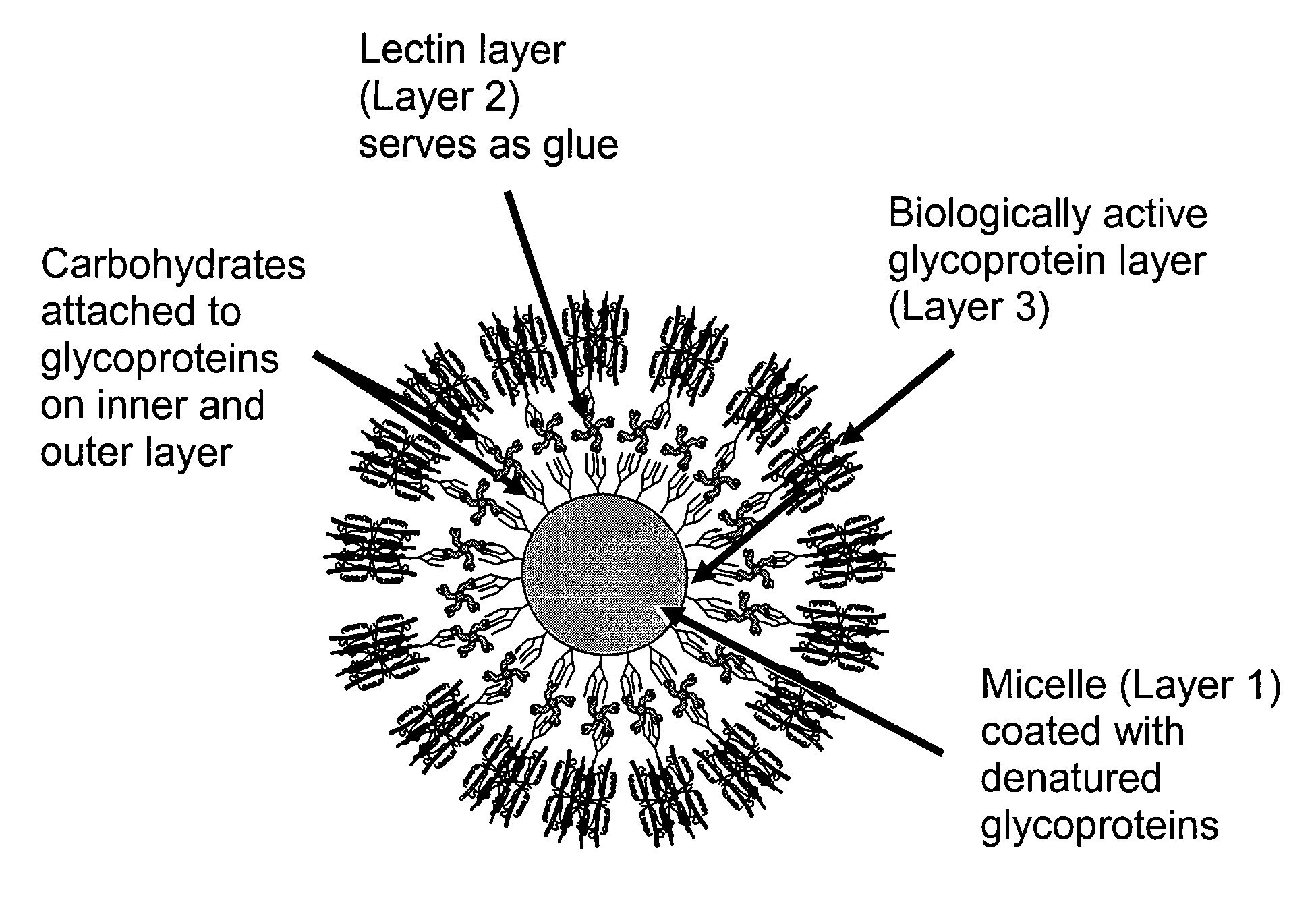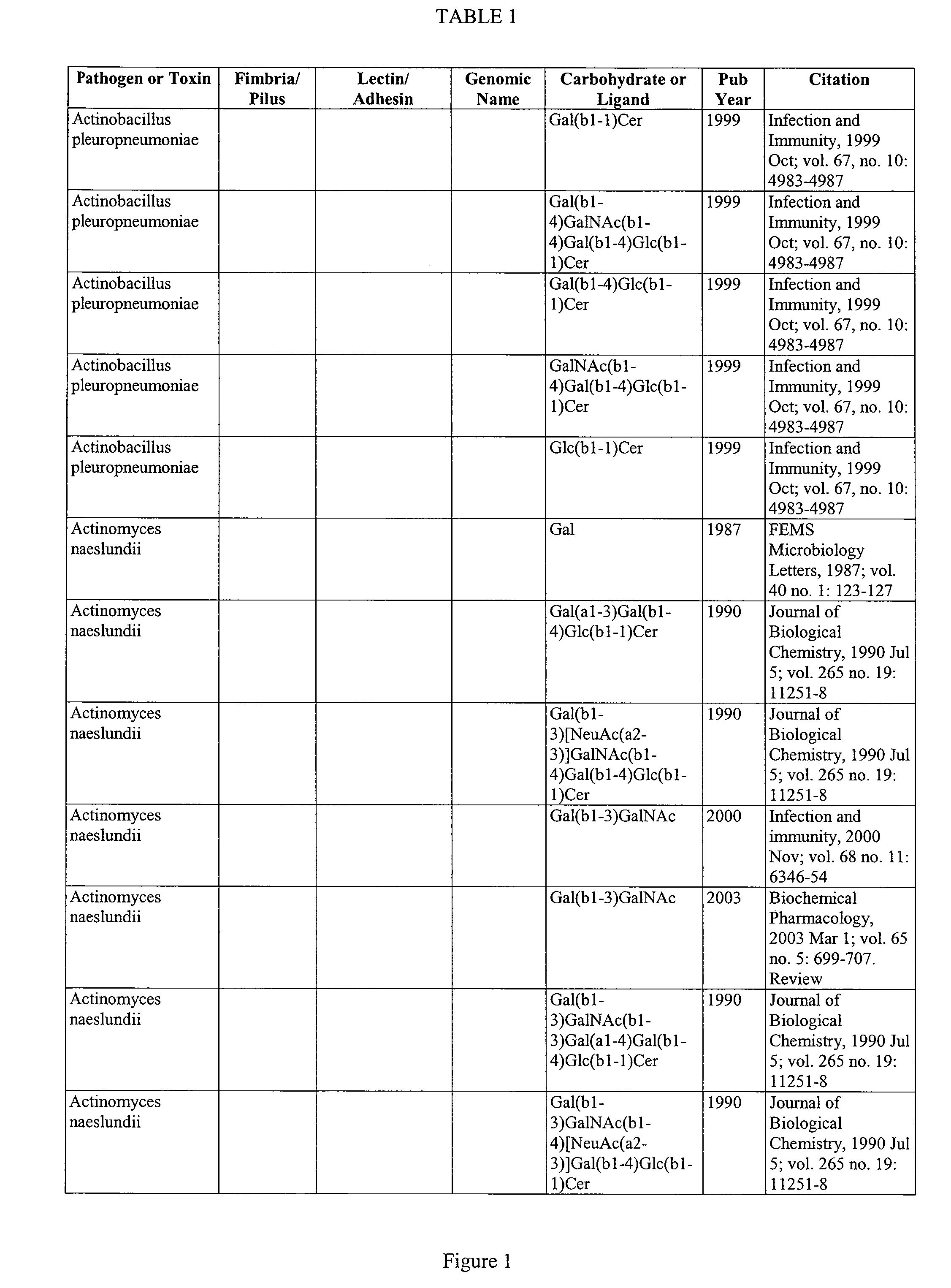Glycoprotein Vesicles and Their Methods of Use
a glycoprotein and glycoprotein technology, applied in the direction of material analysis through optical means, instruments, testing water, etc., can solve the problems of short-term disruption of water service, serious medical, public health, economic, and social consequences, and the potential targets of terrorist activity of water supplies and water distribution systems
- Summary
- Abstract
- Description
- Claims
- Application Information
AI Technical Summary
Benefits of technology
Problems solved by technology
Method used
Image
Examples
example 1
[0103]The following example describes an assay using fluorescent lectins to evaluate the prevalence of carbohydrate structures on micelles. The experiments used the plant lectins, Galanthus nivalus agglutinin, Griffonia simplicifolia II and concanavalin A, which verified the presence of typical hen white glycans on micelles derived from ovomucoid (trypsin inhibitor from Sigma).
[0104]Glycoprotein films were agitated to produce micelles ranging in diameter from about 10 to about 200 μm. Oil filled micelles floated to the surface of the aqueous solution and sorted vertically by size. The micelles were then rinsed to remove excess glycoprotein and stored in water or buffer. 10 μl of small glycoprotein micelles (average diameter 5 to 20 μm) [I will soon be able to verify this. We will receive training on a Beckman-Coulter counter that will provide size distributions.] were exposed to about 20 μl fluorescein-labeled lectin (˜20 μg / ml) buffer) for a minimum of 15 minutes, with occasional g...
example 2
[0107]The method described below involves the production of compound micelles in which lectin-stabilized, inverse micelles (fluorescent) are included within the oil fraction inside larger carbohydrate-coated micelles. The purpose of this procedure is to produce a visible signal that is useful in detecting lectin-carbohydrate binding events.
[0108]An aqueous solution of lectins is added in droplets to oil containing inverse glycoprotein micelles filled with glycoprotein solution. The outer oil-coated faces of glycoprotein micelles are unstable, and open when they come into contact with water. The micelles would merge with droplets of lectin solution. The fluorescent signal would be trapped within micelles prepared with oil containing a stabilized suspension of inverse micelles.
[0109]This method adds lectins inside already-formed inverse micelles with carbohydrates facing inward. The purpose of this technique is: (a) to prevent agglutination of carbohydrate-coated micelles by lectins (...
example 3
[0110]The method described below was used to test the enzymatic activity of single-layered micelles coated with an enzyme compared to micelles coated with an enzymatically active enzyme tethered to a sandwiched lectin layer.
[0111]The activity of invertase was established by the following experiment: 6 mg baker's yeast invertase from S. cerevisiae (Grade VII from Sigma-Aldrich, activity 300 units / mg) was mixed into 6 ml distilled water and lightly vortexed in a capped glass tube. A 16 microliter aliquot of invertase solution was added to 40 ml sucrose solution (0.29 molar) in a plastic Fisherbrand test tube and placed in a waterbath at 55 degrees C. Samples of the invertase-sugar solution were taken at 15-minute intervals to determine the time required for enzymatic activity to take place at this concentration. The assay for invertase activity was performed as follows: A 40 microliter aliquot of invertase-sugar solution was mixed with 16 microliters of Benedicts reagent in a Safe-loc...
PUM
| Property | Measurement | Unit |
|---|---|---|
| diameter | aaaaa | aaaaa |
| diameter | aaaaa | aaaaa |
| diameter | aaaaa | aaaaa |
Abstract
Description
Claims
Application Information
 Login to View More
Login to View More - R&D
- Intellectual Property
- Life Sciences
- Materials
- Tech Scout
- Unparalleled Data Quality
- Higher Quality Content
- 60% Fewer Hallucinations
Browse by: Latest US Patents, China's latest patents, Technical Efficacy Thesaurus, Application Domain, Technology Topic, Popular Technical Reports.
© 2025 PatSnap. All rights reserved.Legal|Privacy policy|Modern Slavery Act Transparency Statement|Sitemap|About US| Contact US: help@patsnap.com



